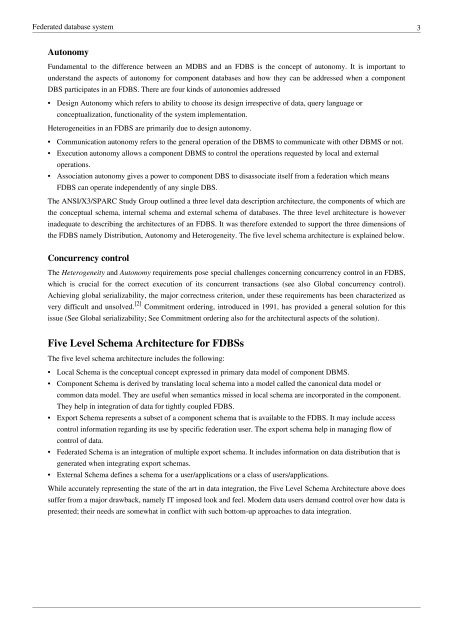Federated database system
Federated database system
Federated database system
Create successful ePaper yourself
Turn your PDF publications into a flip-book with our unique Google optimized e-Paper software.
<strong>Federated</strong> <strong>database</strong> <strong>system</strong> 3<br />
Autonomy<br />
Fundamental to the difference between an MDBS and an FDBS is the concept of autonomy. It is important to<br />
understand the aspects of autonomy for component <strong>database</strong>s and how they can be addressed when a component<br />
DBS participates in an FDBS. There are four kinds of autonomies addressed<br />
• Design Autonomy which refers to ability to choose its design irrespective of data, query language or<br />
conceptualization, functionality of the <strong>system</strong> implementation.<br />
Heterogeneities in an FDBS are primarily due to design autonomy.<br />
• Communication autonomy refers to the general operation of the DBMS to communicate with other DBMS or not.<br />
• Execution autonomy allows a component DBMS to control the operations requested by local and external<br />
operations.<br />
• Association autonomy gives a power to component DBS to disassociate itself from a federation which means<br />
FDBS can operate independently of any single DBS.<br />
The ANSI/X3/SPARC Study Group outlined a three level data description architecture, the components of which are<br />
the conceptual schema, internal schema and external schema of <strong>database</strong>s. The three level architecture is however<br />
inadequate to describing the architectures of an FDBS. It was therefore extended to support the three dimensions of<br />
the FDBS namely Distribution, Autonomy and Heterogeneity. The five level schema architecture is explained below.<br />
Concurrency control<br />
The Heterogeneity and Autonomy requirements pose special challenges concerning concurrency control in an FDBS,<br />
which is crucial for the correct execution of its concurrent transactions (see also Global concurrency control).<br />
Achieving global serializability, the major correctness criterion, under these requirements has been characterized as<br />
very difficult and unsolved. [2] Commitment ordering, introduced in 1991, has provided a general solution for this<br />
issue (See Global serializability; See Commitment ordering also for the architectural aspects of the solution).<br />
Five Level Schema Architecture for FDBSs<br />
The five level schema architecture includes the following:<br />
• Local Schema is the conceptual concept expressed in primary data model of component DBMS.<br />
• Component Schema is derived by translating local schema into a model called the canonical data model or<br />
common data model. They are useful when semantics missed in local schema are incorporated in the component.<br />
They help in integration of data for tightly coupled FDBS.<br />
• Export Schema represents a subset of a component schema that is available to the FDBS. It may include access<br />
control information regarding its use by specific federation user. The export schema help in managing flow of<br />
control of data.<br />
• <strong>Federated</strong> Schema is an integration of multiple export schema. It includes information on data distribution that is<br />
generated when integrating export schemas.<br />
• External Schema defines a schema for a user/applications or a class of users/applications.<br />
While accurately representing the state of the art in data integration, the Five Level Schema Architecture above does<br />
suffer from a major drawback, namely IT imposed look and feel. Modern data users demand control over how data is<br />
presented; their needs are somewhat in conflict with such bottom-up approaches to data integration.
















